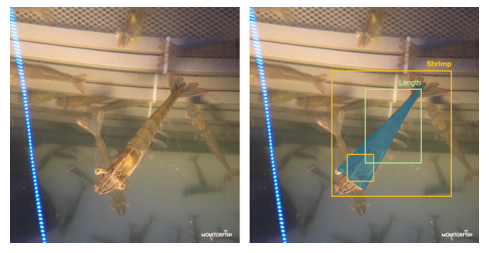ARTIFICIAL INTELLIGENCE IN AQUACULTURE: APPLYING IMAGING ANALYSIS AND ACOUSTICS
Introduction
In domestic shrimp farming, the monitoring of important production parameters (health status, biomass, feed rates and growth success of the animals) is still largely manual, which entails an enormous amount of time and high susceptibility to errors and also causes stress and, in some cases, physical damage to the animals.
The objective is to develop a digital monitoring technology (based on imaging and acoustics data) that enables a qualitative and quantitative assessment of the condition of the entire livestock population and provides the breeder with the data on a smartphone / tablet or computer via an interface. Real time recording and immediate automated decision making in land-based breeding systems for shrimp will make catch unnecessary, reduces hence stress and risk of injury to the animals and provides the farmer with information at all times about the actual biomass of its system as well as about the condition of the animals.
Material & methods
Shrimps are stocked in experimental units at various circumstances (single housed to commercial conditions in terms of density, size, light, etc…). Cameras (model) and hydrophones (icListen – 3500 m; 24-bit Smart Hydrophone – 200 kHz, Model Sb365-ETH, Software Program Marco, Ocean Sonics Ltd.) are installed above the experimental units. Imaging and acoustic recordings will be performed at various circumstances (from acoustically insulted settings to complex acoustic commercial environments, or, at various shrimp size and location, at feeding and absence of feeding). Further data recorded manually are number of shrimps, weight and biomass, mortality, Signs of illness / stress. In addition, the standard built-in sensors continuously record the water quality.
Results
At EAS 2021 preliminary results of imaging analysis and hydrophonic recordings will be presented. Experiments are currently conducted and first data will be available and analysed prior to this conference. We aim to present:
- Preliminary results of digital/automated counting the number of shrimp individual
- Preliminary results of intrinsic acoustic feeding signals from shrimp isolated in a disturbed acoustic environment
Discussion and conclusion
At EAS 2021 preliminary results on automated counting and acoustic feeding signals (considered key data for successful software development) will be presented. Reliability of first data (number of digital counts vs manual counts and acoustic feeding signal vs state of hunger) will be discussed and approaches for recognition algorithms that compares the metadata with a database on shrimp behavior will be presented.
